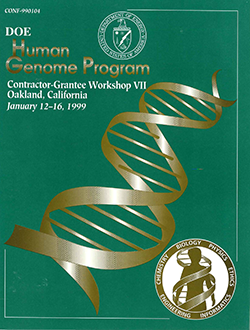1999 DOE Human Genome Program Contractor-Grantee Workshop VII
Abstract Book PDF
(scanned from original)

Research Abstracts from the DOE Human Genome Program Contractor-Grantee Workshop VII
January 12-16, 1999 Oakland, CA
Welcome to the Seventh Contractor-Grantee Workshop sponsored by the Department of Energy (DOE) Human Genome Program (HGP). This workshop provides a unique opportunity for HGP investigators to discuss and share the successes, problems, and challenges of their research as well as new material resources and software capabilities. The meeting also provides scientists and administrative staff with an overview of the program’s progress and content, a chance to assess the impact of new technologies, and, perhaps most important, a forum for initiating new collaborations.
We hope you will take advantage of opportunities offered by this meeting and by the beautiful surroundings of the San Francisco-Oakland Bay area. We also hope you will visit the DOE Joint Genome Institute’s new Production Sequencing Facility (PSF) in Walnut Creek. This facility is scheduled to be opened officially in the spring by the Secretary of Energy Bill Richardson.
The 193 abstracts in this booklet describe the most recent activities and accomplishments of grantees and contractors funded by DOE’s long-running human and microbial genome programs, as well as early efforts in model organism and functional genomics research. In addition, we have included talks from invited guests who will discuss related efforts in other species and opportunities for postgenomic biological investigations enabled by genome research. All projects funded by the Office of Biological and Environmental Research (OBER) will be represented at poster sessions at the Oakland Marriott Hotel, so you will have the opportunity to meet with researchers. New informatics resources also will be demonstrated during the poster sessions, and I urge you to take full advantage of them.
The main challenge facing the genome program today remains high-throughput sequencing. Two years ago, DOE addressed this challenge by forming the Joint Genome Institute (JGI), under the direction of Elbert Branscomb. JGI employs the complementary strengths of DOE’s three largest genome programs and those at other laboratories and universities to make more efficient and effective use of diverse expertise and resources.
In the past year, we gave JGI two very challenging and difficult tasks:
- Sequence a total of 20 Mb of DNA to “Bermuda standards,” and
- Successfully occupy the PSF building in Walnut Creek.
JGI has met both of those ambitious goals. As of October 23, 1998, it had submitted to GenBank a total of 21 Mb, all with Phred/Phrap values of 40 or greater. This represents a tenfold increase over the amount of DNA sequenced by all three DOE genome centers in the previous year; currently, the sequencing rate averages 3 Mb per month. And, as noted, PSF is open, halfway between the Lawrence Berkeley and Lawrence Livermore national laboratories. PSF’s goal this year is 40 Mb, a doubling of last year’s yield.
Also last October, the U.S. Human Genome Project completed and published in Science its third 5-year plan, developed jointly with the NIH National Human Genome Research Institute. This plan was achieved with input from the broad genome scientific community. Although many challenges lie ahead, particularly in anticipating and preparing for the “postgenomic” world, we are more optimistic than ever about the success of this grand project and its many contributions to science and society. Yet we cannot afford to be complacent, either, and the workshop speakers on the ethical, legal, and social implications will remind and challenge all of us that our science has societal impacts and we cannot be aloof and disengaged from those interactions.
There are other genomes to sequence besides the human, and the OBER Microbial Genome Program continues to contribute complete sequences to public databases. Each microbial sequence has its surprises and its exciting science. One of the more exciting sequences completed in 1998 was the entire 3-Mb sequence of Deinococcus radiodurans, the most radio-resistant microbe yet known; its astounding DNA-repair capacities represent longstanding and continuing high-priority DOE interests and the opportunity, perhaps through genetic engineering of toxin-degrading enzyme systems, to address DOE’s mission of mixed-waste remediation. This achievement also underscores the opportunity to exploit the interdisciplinary biological approaches that we view as important guiding principles for the science we support. We must continue to take responsibility for using our science to better our world.
We anticipate a very interesting and productive meeting and offer our sincere thanks to all the organizers and to you, the scientists whose vision and efforts have realized and continue to realize the promises of genome research.
Sincerely,
Ari Patrinos
Associate Director
Office of Biological and Environmental Research
U.S. Department of Energy
[email protected]
Date Published: December 1998
Prepared for the U.S. Department of Energy, Office of Science, Office of Biological and Environmental Research, Washington, D.C. 20874-1290
Prepared by
Human Genome Management Information System
Oak Ridge National Laboratory
Oak Ridge, TN 37830-6480
Managed by LOCKHEED MARTIN ENERGY RESEARCH CORP.
for the U.S. DEPARTMENT OF ENERGY
UNDER CONTRACT DE-AC05-96OR22464
